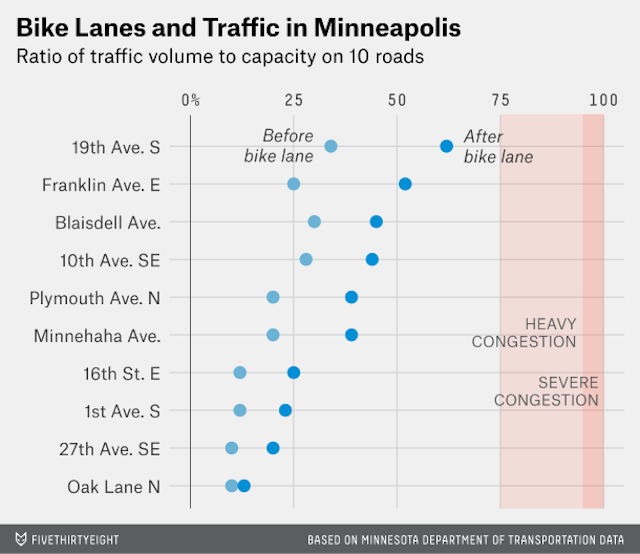The battle against bike lanes has turned into an all-out culture war, with NIMBYs shrieking about ceding centimetres of precious asphalt while squawking about the apocalyptic congestion that change will bring. But here’s a deep, data-driven investigation into the truth about bike lanes and traffic.
Two researchers from statitician Nate Silver’s new site FiveThirtyEight, Gretchen Johnson and Aaron Johnson, tackled the age-old question: When cities add lanes to make life better for bikers, do they also end up making life worse for drivers? To investigate, they looked at Minneapolis — which is often cited as one of the best cities in the country for biking — specifically, 16km of its new bike lanes where a lane of car traffic was removed.
Using Minneapolis’s Average Annual Daily Traffic counts on those streets, they were able to calculate the number of cars travelling in the busiest direction during peak travel time and divide that by the total road capacity for a volume-to-capacity ratio, or V/C ratio. A very low V/C ratio means no congestion. As the V/C ratio approaches 1, or 100 per cent, you’ll be stuck in traffic. Anything over 0.75 is going to impact your commute.

As you can see for these 10 lanes, the V/C did go up, but not up enough to actually cause heavy or even severe congestion. But what’s interesting to note is the comparison of the V/C ratios before and after: The streets that already had low V/C ratios saw the smallest increases in traffic volume. This is key, according to Johnson and Johnson:
This is an important point: Bike lanes don’t cause a lot more congestion if you put them on the right streets. If you cut down the size of streets that are already near capacity, you’ll create severe congestion. But if you start with roads that are well under capacity, you’ll only increase the congestion a little bit. And it may not even be noticeable. Slimming down these roads that are too “fat” is known as a road diet — and yes, that is the technical term.
To test their theory, they looked at correlations between the Minneapolis data and one particular stretch of street in Brooklyn that’s currently home to some of the most vehemently opposed bike lanes in the history of bike lanes. Here, New York City’s DOT collected its own trip data, measuring traffic volume before and after the lanes were installed:

Charting the Prospect Park West lanes using the same metrics, you’ll see that the magic V/C ratios only hit about .5 — not enough to cause additional congestion. And that’s because they were installed on a street that was already performing under capacity.
But that’s not the only good news:
The number of cyclists using the road went up, and speeding cars, cyclists riding on the sidewalk and injury-causing accidents went down. The road diet isn’t just creating a space for bikers; it’s also making the street safer for other types of users.
Presenting the data to prove that bikes are not impeding traffic might be helpful to change someone’s mind, but this almost makes a better case for why bike lanes are a good idea: Bike lanes are actually helping to build safer streets. [FiveThirtyEight]
Pictures: Spencer Platt/Getty Images; charts: FiveThirtyEight
